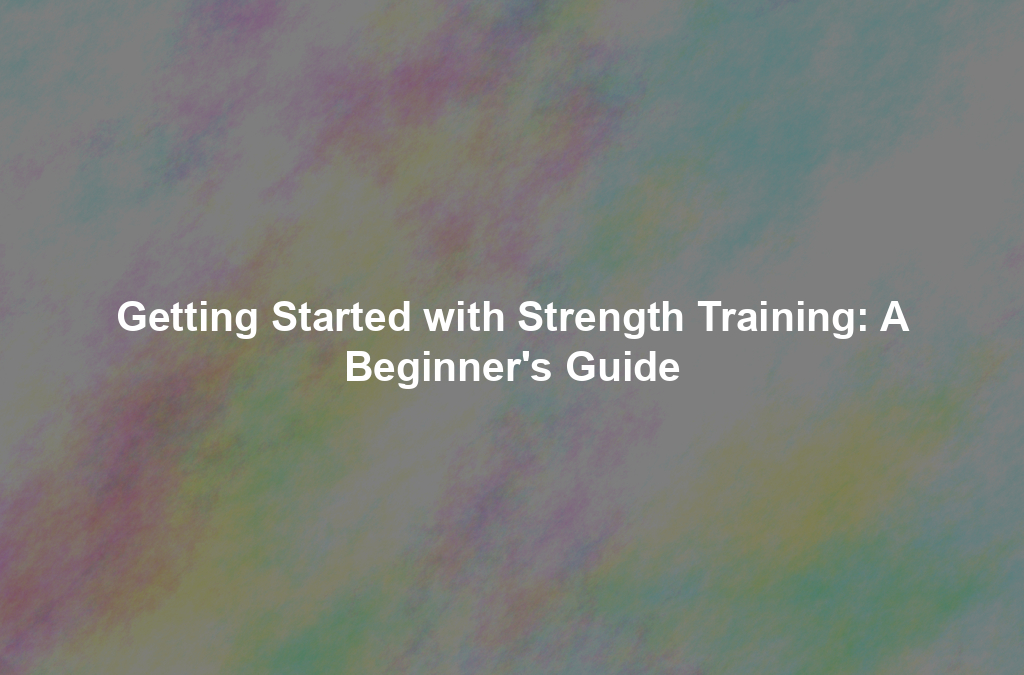
Getting Started with Strength Training: A Beginner’s Guide

Strength Training for Beginners: Building a Solid Foundation involves exercises that challenge your muscles to work harder, making them stronger and more enduring. While some believe it only increases muscle size, it actually shapes and defines them. Embracing a beginner’s mindset is crucial for success. Start with simple exercises and focus on learning the correct techniques. Beginning strength training helps establish a strong foundation. Enjoy the journey and watch your body transform.
Strength Training for Beginners: Building a Solid Foundation
What is Strength Training?
Strength training means doing exercises that make muscles work harder. This helps muscles get stronger and last longer. Muscles push against things like weights, bands, or your own weight. Important parts are resistance, repetition, and progression. Start with light weights and add more as you grow stronger.
There are different strength exercises. Resistance training uses weights or bands. Bodyweight exercises like push-ups use your body as weight. Isometric exercises mean holding still, like in planks. Each type has its own benefits and challenges.
Benefits of Strength Training
Strength training gives many physical benefits. Muscles become strong and defined. It boosts power and speed too. You can do daily tasks easier because endurance grows. Your metabolism speeds up, helping with weight control. A study by the National Institutes of Health shows these gains in strength.
Mental benefits come from strength training too. Confidence rises as you improve skills. Stress goes down, and mood gets better. Exercise releases endorphins which lift mood naturally. Strength training also makes you feel proud and raises self-esteem.
For beginners, strength training builds a strong fitness base for life. Starting simple and using correct form prevents injuries. The New York Sports Medicine Institute stresses proper technique care is key here too! Warm up before workouts; listen to your body’s needs! Rest days help muscles recover well.
Strength training isn’t just lifting weights; it’s about building a strong base for future workouts! Enjoy this journey while watching your body change!
Getting Ready for Strength Training
Starting strength training is exciting but can feel scary. Don’t worry; having clear goals and knowing your gear helps a lot.
Setting Goals
Goals give you direction and energy. Short-term goals help you focus on quick wins. Maybe aim to work out a few times weekly. Long-term goals are about bigger changes, like getting stronger over months.
Tracking progress is key in strength training. Write down workouts and see how you improve. This boosts motivation and helps change goals if needed. Use a notebook or app to track easily.
Important Gear
Right gear makes training better and more fun. Beginners need just a few things:
- Exercise Mat: Gives comfort during floor moves.
- Resistance Bands: Provide flexible resistance for exercises.
- Adjustable Dumbbell: Lets you change weights as you get stronger.
- Kettlebell: Good for active moves and building strength.
Extra gear can make workouts better as you advance:
- Bench: Helps with bench presses and step-ups.
- Gliding Discs: Add challenge to exercises.
- Jump Rope: Great for warming up and cardio fitness.
- Medicine Balls: Perfect for core work and adding intensity.
Strength Training for Beginners means starting with the right mindset and tools. The right goals and equipment lead to success. Enjoy the journey as your body changes.
Making a Beginner’s Strength Training Plan
Planning Your Workout Times
How Often and How Long to Exercise
Begin with two or three workouts weekly. Each should be 30 to 45 minutes long. This helps your body get used to new moves. Being regular makes you stronger over time.
Working Different Muscle Areas
Work on different muscles each session. Do upper body one day, lower body the next. Always add core exercises too. This stops any one part from getting too tired.
Easy Exercises for Beginners
Upper Body Moves
- Push-Ups: Build chest, shoulders, and arms.
- Dumbbell Rows: Use light weights for back muscles.
- Overhead Presses: Use bands for shoulder work.
Lower Body Moves
- Squats: Strengthen thighs and glutes.
- Lunges: Help balance and leg strength.
- Glute Bridges: Focus on hips and lower back.
Core Building Moves
- Planks: Improve core stability.
- Russian Twists: Add a ball for more resistance.
- Leg Raises: Work on lower belly muscles.
A therapist suggests using bands or light weights. Stretching and cardio get you ready for lifting weights. This keeps training safe and effective.
Making a plan that fits your life makes training fun. Start slow and gain confidence each time.
Safety Tips and Best Practices
Avoiding Common Injuries
Importance of Proper Form
Good form keeps you safe when lifting. Right techniques stop injuries and make workouts work well. Focus on each move. Use mirrors or film yourself to check. A Physical Therapist says, “Focus on good form for best results.” This advice helps avoid extra strain.
Listening to Your Body
Your body sends signals. Notice any discomfort or pain. Stop if something feels off. Rest is key for healing. An Orthopedic Specialist suggests getting help if pain stays. Expert advice keeps you safe without injury.
Staying Motivated and Consistent
Overcoming Plateaus
Plateaus are when progress stops. Change your routine to move forward. Try new moves or lift more weight. Celebrate small wins to stay motivated. Remember, every step helps reach your goals.
Finding a Workout Buddy or Community
A workout buddy makes exercise fun. Friends give support and cheer you on. Join a gym class or online group. Sharing stories boosts motivation. Working out together builds belonging and responsibility.
Strength training offers a path to a healthier and stronger you. You learned about the basics, benefits, and essential gear. You explored how to create a routine and stay safe. Now, take the first step on your strength training journey. Start with lighter weights and focus on proper form. Seek guidance from professionals if needed. Remember, consistency is key. For more tips and expert advice, check out resources like the New York Sports Medicine Institute and Peak Orthopedic. Embrace this journey and watch your strength grow!


